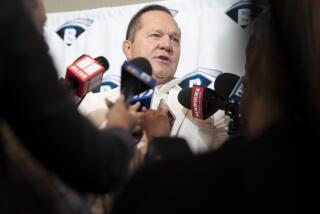BASEBALL / ROSS NEWHAN : The Players Had Little Choice but to Strike
- Share via
With due respect to colleague Mike Downey, his column in Monday’s editions of The Times, headlined, “It’s Time for Players to Return,” demanded response.
In writing that it was the players who are to blame for creating and maintaining the baseball strike, and it’s time for them to return and continue negotiating in the off-season, Downey strays so far off base that he becomes vulnerable to pickoff.
Make no mistake: It was the owners who forced the players out and are keeping them out.
Make no mistake: The players can’t simply return and resume negotiations when the season ends, as Downey wrote, because they know there will be no negotiations when the season ends. They know that if they return now with the naive hope of resuming negotiations in November, they have no leverage against the certainty of the owners declaring an impasse and unilaterally implementing their last, best offer, which would include a salary cap, elimination of arbitration and severe restrictions on free agency.
This is the salient point, the central issue behind the players’ strike, and Downey ignored it.
The owners have steadfastly refused to waive the right to implement in return for a no-strike pledge from the union.
Are the players supposed to blithely return, knowing this stoppage is their only weapon against the threatened loss of 20 years of negotiating progress?
The owners are certain to implement even if the players remain out, but the strike hammers at the clubs financially, eats at the owners’ unanimity, and possibly reawakens Congressional interest in removing baseball’s antitrust exemption.
If the owners did not have the exemption, there would be no strike.
The players, in that case, could go to court to seek injunctive relief against unilateral imposition of a new compensation system.
Without that option, the players’ only leverage was the strike.
Keep in mind, as well, that it was the owners who voted to reopen negotiations a year early, on Dec. 7, 1992, and then did not make their salary-cap proposal until June 14, 1994, a delay of 18 months that wasted the year’s head start. It painted the players into a difficult corner because the bargaining agreement had by then expired, and created the impression--as the union has maintained from the start--that management is operating on a calendar that leads directly to creation of a system that the owners have always known the players wouldn’t accept.
The players knew what was coming and considered striking late last year, but decided to wait in the hope that good-faith negotiations could produce a compromise.
They considered striking at the All-Star break this year but were talked out of it by the owners, who based their appeal on the importance of the game to Pittsburgh and baseball’s new television deal. The players played, and the owners showed their appreciation by withholding a $7.8-million pension payment due the union from receipts of the game.
It can be said that 25 years of mistrust are hampering these negotiations, but that would assume there have been negotiations, which there haven’t--on a substantive level, at least. The players, skeptical of the owners’ financial claims, want to maintain the status quo. The owners, believing that revenue disparities between the clubs will erode competitive balance and that the small-market teams can’t survive without a system that establishes a link between revenue and player compensation, remain committed to their salary-cap proposal.
The players, by contrast, are not above give-backs or compromise. They would consider eliminating or modifying arbitration in return for earlier free agency if the cap came off, but the owners have been intransigent, unwilling to remove the cap because they consider it pivotal to their last, best offer, if it comes to unilateral implementation.
It was also the owners who changed their voting rules to make it more difficult for any faction--hawks, doves, moderates--to broker a compromise. A settlement must now be approved by 21 of the 28 clubs, rather than a majority, and to change the rule back to a majority requires three-fourths approval of each league.
Should the players simply swallow all of this and return, accepting Downey’s advice? Many would agree, citing the average major league salary of $1.2 million, the players’ annual licensing checks of $70,000 or so and their lavish benefits package.
How much more do they need, some might ask, but this is not about feeling sorry for them. The players know they will always be portrayed as the greedy bad guys. They aren’t going to win a public relations contest no matter what the issues are, but they haven’t become one of the nation’s strongest unions worrying about fan reaction.
This eighth work stoppage since 1972 is one more attempt, in the players’ view, to break the union, and they will hold out and hold firm again. Downey will disagree, but it’s a position they were forced to assume and defend. It’s the owners, spitting on the season, who put them there and who bear the responsibility for bringing them back.
More to Read
Go beyond the scoreboard
Get the latest on L.A.'s teams in the daily Sports Report newsletter.
You may occasionally receive promotional content from the Los Angeles Times.










